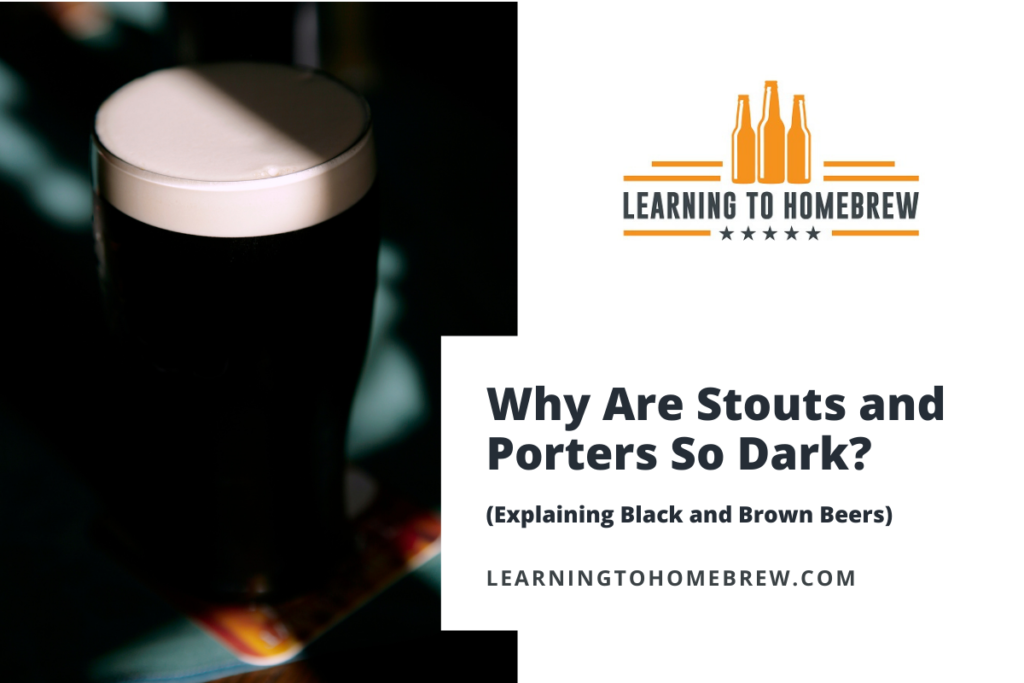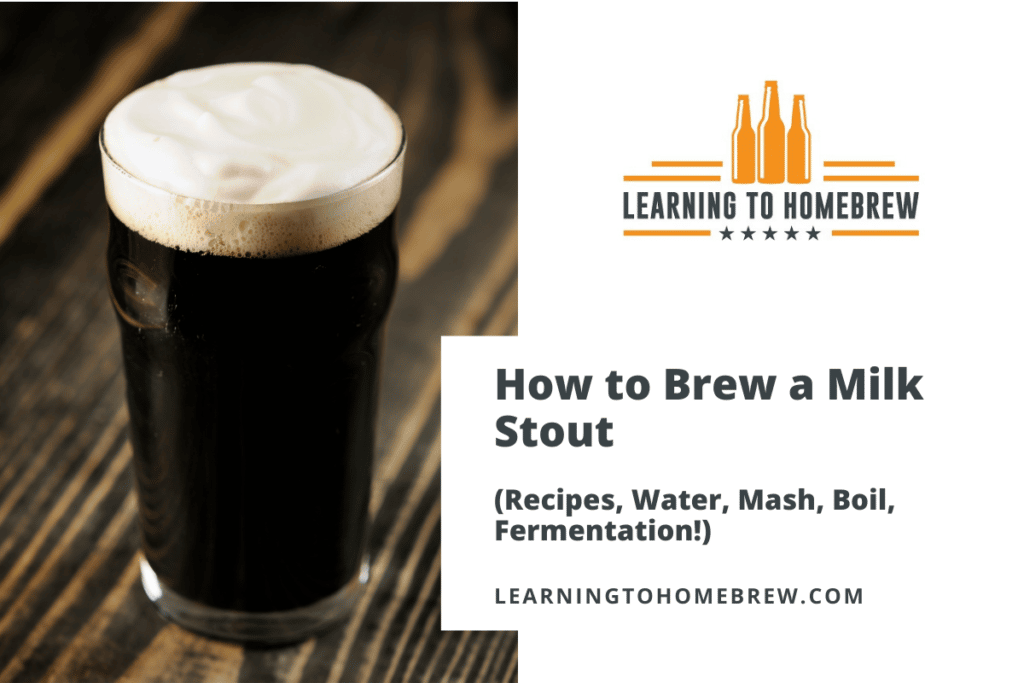Stouts and porters have their similarities, but they also have their differences. Each offers a unique flavor profile and drinking experience. If you like either porters or stouts, you’d like the other. What’s the main difference between the two, and how are they similar?
The difference between stouts and porters is the ingredients used. Porters do not use roasted barley but instead use crystal, chocolate, or brown malt for a sweeter taste. Porters have a mild bitterness and mouth-coating feel. Stouts use roasted barley as the main ingredient and have a high bitterness. They contain notes of coffee and chocolate.
Continue reading for more information on the differences and similarities between the two styles. We’ll discuss the history of each style, tasting notes, availability, and different substyles amongst the two.
Topics We Cover
Differences and similarities between stouts and porters
Stouts and porters are notorious for having similar characteristics that make them tough to differentiate between. The two styles, however, are more different than people think. The main difference between the two is the ingredients and their imparting flavors.
The main difference between stouts and porters is the ingredients–mainly the malt used. Crystal malt is common in porters and imparts a certain sweetness to the beer. Stouts get their flavor from roasted barley. Each style is dark in appearance and originated in the United Kingdom, but porters came first.
The differences between stouts and porters are minute. Although they have their differences, they have similarities in taste, aroma, mouthfeel, and appearance that we’ll touch on in greater detail throughout the article.
History
Stouts and porters are each a product of creativity and brewing ingenuity, with the inception of each style occurring in the United Kingdom. Brewers recently developed tools like the hydrometer and were able to intensify beers with greater accuracy and consistency. It was around this time, in the 1720s, that porters came to be.
The porter came before the stout. In the 1720s, brewers decided to expand the color palates of their beers by using burnt sugar instead of malt. These were considered porters and are largely the reason they remain notably sweet. Stouts came to be in 1817 when Daniel Wheeler invented the roasting kiln and applied roasted malt to the grist.
Roasted malt became the difference between the stout and the porter, with one of the greatest disparities between the two styles being the bitterness. The word “stout” was used to describe a strong porter and has since evolved into a separate style consisting of many substyles.
Ingredients
Stouts and porters use similar ingredients for brewing, resulting in similar profiles and characteristics. Each uses hops, yeast, grains, and water but with stylistic uniqueness.
Stouts use roasted barley and chocolate malts to achieve a dark color profile and roasted, coffee-like taste. Porters use crystal malt to achieve incredible sweetness, partnered with brown or dark malts for their slightly lighter colors. Each uses a variety of bittering and aroma hops. Stouts use hop strains with higher alpha acid content.
Aroma
These two styles have distinct aromas – stouts and porters are similar in this sense, but they have their differences.
Stouts have underlying coffee and chocolate aromas with subtle medium to high hop aromas. Porters offer more bready and grainy aromas with a mixture of chocolate and coffee. There are fewer roasted notes in porters than there are in stouts.
Taste
Stouts and porters are known for their dark tastes of coffee, chocolate, and dark fruits.
Stouts have roasted flavors of coffee and chocolate. The tastes come from the roasted malts and hops used. Porters have a sweet taste of malt and cocoa, often without roasted flavors. Porters can have bready, toffee, and caramel flavors. Both stouts and porters have a low to high bitter taste.
Bitterness
Stouts have a sharper and more potent bitterness than porters. The bitterness comes from the ingredients used.
Stouts have medium to high bitterness. Porters have a low to medium bitterness that pairs with the style’s sweet flavors. Stouts’ rich and deep coffee and chocolate flavors partner with its bitterness, which comes from the malts and hops used. Stout IBU ranges from 35-60 and porter IBU ranges from 25-40.
Sweetness
In terms of sweetness, stouts and porters differ quite a bit.
Porters are sweeter than stouts. Porters use more crystal malt and have a medium sweetness that pairs with the light bitterness of the style. Stouts do not typically use crystal malt or other sweet grains and have a low to medium malt sweetness.
Mouthfeel
The difference in mouthfeel between these two styles sets them apart more than other characteristics, ranging from thin to thick.
Stouts have a thicker mouthfeel than porters. Milk stouts and nitrogenated stouts have a significantly thicker mouthfeel than porters and other substyles. Porters still retain a thicker mouthfeel than other styles, but each is mouth-coating with a slightly dry finish.
Alcohol Content (ABV)
Stouts and porters have a wide range of alcohol contents because of their substyles.
Stout ABV ranges from 5.7-8.9% and porter ABV ranges from 5.1-6.6%. Baltic-style porters are a high-ABV porter with a 7.6-9.3% range. Imperial stouts have the greatest ABV range at 7-12%.
Availability
It’s easier to find a stout than it is a porter, but each is pretty common.
Stouts and porters are available year-round. Stouts are more common than porters amongst craft breweries, but the two styles are produced year-round. Barrel-aged stouts are revered as collector’s items in some cases and, because of their high demand, availability can become scarce.
Stout substyles
Stouts have a unique flavor profile with loads of roasted flavors and aromas partnered with different hop profiles and high bitterness. Each stout substyle uses roasted malt to achieve a dark, often jet-black, appearance. The styles encompass a wide ABV range with Irish dry stouts as low as 3.2% and imperials sitting at 12%.
- American stout – Prominent coffee and roasted malt aroma and taste. Low to medium malt sweetness with caramel, chocolate, or roasted coffee attributes present at low to medium levels. Distinctly bitter.
- American imperial stout – Vibrant malt aroma from roasted barley and prominent malt sweetness met with high bitterness—moderate malt astringency with a medium-high American hop flavor and aroma.
- Sweet/milk stout – Dominant chocolate and caramel taste and aroma from malts used. Minimal to nonexistent hop profile with low-medium bitterness to balance the sweetness. These stouts use milk sugar to add residual sweetness and a fuller mouthfeel.
- Oatmeal stout – Brewed with Oatmeal in the grist to provide a fuller flavor. Contain a silky mouthfeel. Coffee, caramel and roasted malt flavors are prominent and smooth with minimum bitterness.
- Irish dry stout – Dry malt flavors from roasted barley lend dry stouts a roasted flavor and aroma. European hop character is mild to not present and bitterness is medium-high. Persistent head retention.
- Coffee stout – Stouts brewed using coffee beans, brewed coffee, specialty-brewed coffee, or coffee extract. Coffee flavor and aroma from the malt are enhanced by coffee adjuncts. These stouts contain small amounts of caffeine.
- Oyster stout – Brewed with oyster shells. Often contain sea salt, calcium and other relevant adjuncts. Oysters are used to clarify beers. Isinglass, a protein found in the bladders of some types of fish, is used to help yeast cells flocculate and improve the beer’s clarity.
Porter substyles
Porters are like stouts but with fewer roasted flavors and reduced bitterness. Some porter substyles offer fruity esters and greater malt sweetness to complement each other. Alcohol content varies greatly between the substyles from 3.3%-12% ABV.
- Robust porter – Brown to almost black. Malt flavor and aroma is medium-high hints of roasted malt, cocoa and caramel. Dark malt bitterness balances the malty sweetness. Fruity esters are present but not overwhelming. Bitterness is medium to high.
- Baltic-style porter – These beers are brewed with lager yeasts and are fermented cold. Malt sweetness is medium-low to medium-high. Aromas consist of caramelized sugar and dark sugars with some subtle licorice notes. Low bitterness with high levels of dark fruitiness, including notes of berries, grapes, and plums.
- English-style brown porter – Low-medium malt sweetness with caramel and chocolate notes. Very little to zero notes of roasted barley or burnt malt character. Very low hop flavor and aroma with medium bitterness. Fruity esters may be present.
- American imperial porter – No roasted barley or burnt flavors with medium malt sweetness. Caramel and cocoa sweetness can be present. Low hop flavor and aroma with low bitterness. Fruity esters are present and pair with hop characters and sweetness.
- Smoke porter – An interesting substyle. Mild to prominent smoke malt aroma and flavor. Specific substyle of porter can be smoked and can lend different attributes contingent on the style used. Black malt character can be present in some but nonexistent in others. Zero to medium hop flavor and aroma, low to medium fruity esters.





